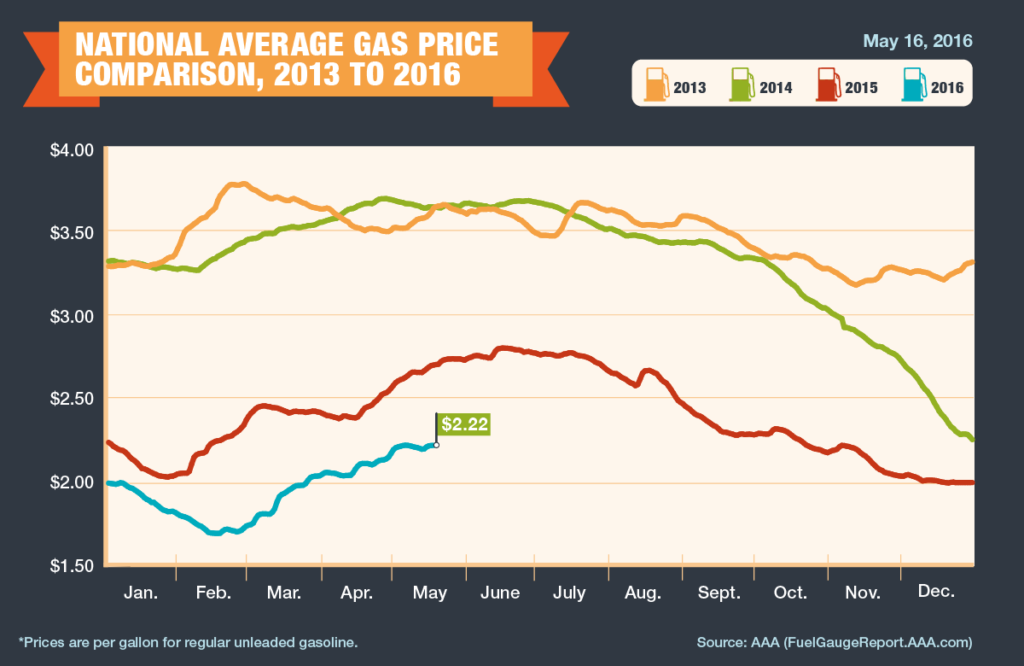The national average price of gasoline increased slightly over the past week, and it is likely that prices are heading for a new 2016 high in the coming days. Gas prices are rising due to more expensive crude oil costs brought about by wildfires in Canada and supply disruptions in other oil-producing countries. Today’s average price of $2.22 per gallon for regular unleaded gasoline represents an increase of 11 cents per gallon on the month, though drivers continue to enjoy a substantial year-over-year discount of 48 cents per gallon.

Gasoline demand regularly increases leading into the summer driving season, and this year has been no exception. According to last week’s supply report from the Energy Information Administration, U.S. gasoline demand hit its highest mark of the year at 9.66 million barrels per day, which was the highest number since August and 4.4 percent higher than the same period last year. While domestic gasoline inventories reportedly decreased by about one million barrels, supplies are still some 14 million barrels higher than a year ago. In response to this seasonal increase in demand, refineries nationwide are ramping up production, although some facilities, particularly in the Great Lakes region, have been impacted by the fires in Alberta, Canada.
Quick Stats
- The nation’s top five most expensive markets are: California ($2.80), Hawaii ($2.67), Washington ($2.55), Alaska ($2.52) and Nevada ($2.48).
- The nation’s top five least expensive markets are: Arkansas ($1.99), Texas ($1.99), Louisiana ($2.00), Mississippi ($2.00) and Oklahoma ($2.00).
- Averages are down in nearly every state year-over-year, with the largest yearly savings experienced by drivers on the West Coast: California ($1.02), Nevada (-81 cents), Alaska (-69 cents), Arizona (-62 cents), Utah (-59 cents) and Oregon (-59 cents).
- Gas prices have increased the most month-over-month in Idaho (+28 cents), Utah (+25 cents), Washington (+23 cents) and Oregon (+23 cents).

West Coast
Drivers on the West Coast continue to pay the nation’s highest averages for gasoline, and the nation’s top five most expensive markets are all in this region: California ($2.80), Hawaii ($2.67), Washington ($2.55), Alaska ($2.52) and Nevada ($2.48). Gasoline stocks continue to exceed last year in the region, which should keep prices relatively steady as more drivers take to the roads. The recent restart of the ExxonMobil refinery in Torrance, California also should help improve regional supplies ahead of the summer driving season.
Gulf Coast
On the other end of the spectrum, the Gulf Coast remains the nation’s least expensive markets for gas, led by Arkansas ($1.99), Texas ($1.99), Louisiana ($2.00), Mississippi ($2.00) and Oklahoma ($2.00). Pump prices are typically lower in this part of the country, based on its proximity to a large number of refineries and relatively low state fuel taxes. While gasoline supplies in most regions have seen draws in recent weeks, Gulf Coast stocks reportedly surged last week by more than two million barrels. With ample supplies and robust production, prices within the region should remain on the lower end of the national spectrum entering the busy summer driving season, provided there are no unexpected disruptions.

Midwest
As has often been the case, volatility has characterized pump prices in the Midwest in recent weeks. Many states in the region reflected double-digit increases two weeks ago, then drops of ten cents or more last week, only to see large gains over the past seven days, led by Indiana (+9 cents), Ohio (+8 cents) and Kentucky (+8 cents).
The fires in Alberta have been burning in a part of Canada that is rich in oil sands, and there has been a significant decline in production. Canadian oil is often cheaper than crude from other parts of the world, and in recent years U.S. refiners have increasingly relied on Canadian imports. Midwestern refineries in particular have changed their production methods to take advantage of heavy Canadian crude oil, which arrives by pipeline. The recent decline in Canadian production has impacted the regional cost of oil and is likely contributing to more expensive gas prices in the Midwest.
East Coast
The Department of Energy reported last week that gasoline inventories were sharply lower, down 2.2 million barrels, on the East Coast. However, the region continues to be well supplied with fuel, and prices have been largely steady in the region over the past week.
Oil Market Dynamics
Global oil prices began this week pointed higher as market watchers continue to evaluate how recent supply disruptions may impact the glut of global crude oil. This includes the impact of wild fires in Canada and ongoing issues in the Middle East, North Africa, Nigeria and Venezuela.
At the close of Friday’s formal trading session on the NYMEX, West Texas Intermediate crude oil was down 49 cents on the day, but up several dollars per barrel on the week to settle at $46.21.
Motorists can find current gas prices along their route with the free AAA Mobile app for iPhone, iPad and Android. The app can also be used to map a route, find discounts, book a hotel and access AAA roadside assistance. Learn more at AAA.com/mobile.
